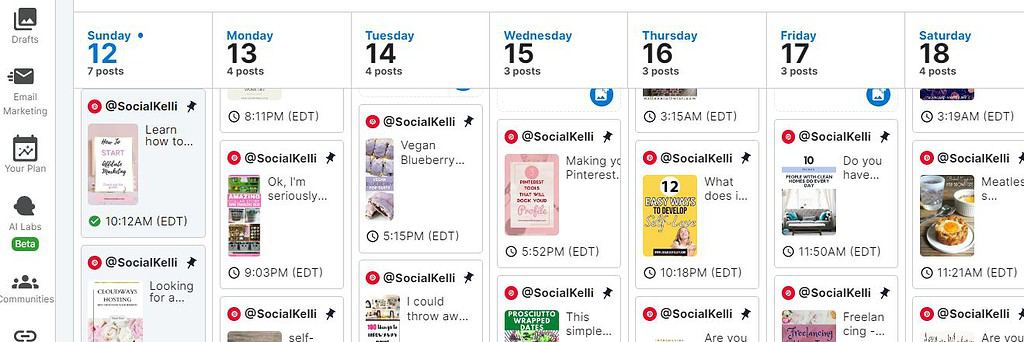
The Importance of Social Media for Business Marketing
Social media marketing has become an integral part of our daily lives and its impact on businesses cannot be ignored. With over 4 billion active social media users worldwide, it is evident that social media platforms are not just for connecting with friends and family, but also for businesses to reach their target market. One of the main advantages of using social media for business marketing is the ability to increase brand awareness.
–This post contains affiliate links. If you use these links to buy something, I may earn a commission-
Social media platforms provide a cost-effective way for businesses to reach a wider audience and build their brand identity. By consistently posting high-quality content and engaging with followers, businesses can create a strong online presence that resonates with their target audience.
Another benefit of social media marketing is increased website traffic. By promoting website links on social media platforms, businesses can drive more traffic to their website and increase the likelihood of conversions.
Additionally, social media platforms have made it easier than ever before to connect with potential customers through targeted advertising. With detailed targeting options such as age, interests, location and more, businesses can ensure that their ads are being seen by the right people at the right time.
In today’s digital age, having a strong social media presence is no longer optional for businesses looking to succeed in the long term. Stay tuned as we delve deeper into how you can use different strategies to leverage social media effectively for your business marketing needs! Or look into becoming a social media marketing manager for other companies!
Choosing the Right Social Media Platforms
The Importance of Choosing the Right Platforms
When it comes to social media marketing, choosing the right platform is crucial for achieving success. With so many social media platforms available, it can be overwhelming to know which ones are best suited for your business. Each platform has its own unique features and audience demographics, so it’s important to do your research before committing to a particular platform.
Popular Social Media Platforms
Some of the most popular social media platforms used by businesses include Facebook, Instagram, Twitter, LinkedIn, Pinterest and YouTube. Facebook is one of the largest social media platforms and is ideal for businesses with a wide variety of products or services. Instagram is great for visual content like photos and videos while Twitter is perfect for short updates and news announcements.
LinkedIn targets professionals and is ideal for B2B marketing while Pinterest focuses on visual bookmarking and discovery. YouTube is best suited for video content.
Selecting the Best Platform for Your Business
In order to select the best platform(s) for your business, you need to consider factors such as your target audience demographics, type of products or services offered and overall goals. For example, if your target audience consists mostly of young adults then Instagram or Snapchat may be a better fit compared to LinkedIn which targets working professionals.
Similarly, if you’re an e-commerce business that relies heavily on visuals then Pinterest may be a better fit than Twitter which focuses more on text-based content. Understanding the unique features of each social media platform and selecting the right ones based on your business goals can make all the difference in achieving success with social media marketing.
Tips to Create a Cohesive Brand Image Across All Social Media Platforms
When it comes to social media marketing for businesses, creating a cohesive brand image across all platforms is essential. This means that your branding elements – such as your logo, color scheme, and tone of voice – should be consistent throughout all of your social media accounts. Follow through with your blog, if you have one, as well. This not only helps with brand recognition but also helps establish trust with your followers.
To achieve this consistency, start by creating a style guide that outlines all the branding elements you want to use. This can include specific colors, fonts, and imagery that accurately represents your brand. Canva is great for this, get started here.
Once you have established these guidelines, use them consistently across all your social media platforms. This helps create a recognizable and memorable impression in the minds of consumers.
The Importance of Engaging With Your Followers and Responding to Comments/Messages
One of the most significant benefits of social media for businesses is the opportunity to engage with customers directly. It’s important not only to post content regularly but also to respond promptly to comments and messages from followers.
When responding to comments or messages, make sure that you are always friendly and helpful. Never ignore negative feedback or complaints – instead, address them professionally and try to resolve any issues as quickly as possible.
Remember that social media is a public forum where potential customers can see how you interact with followers. Engaging with your followers on social media also provides an opportunity for valuable feedback about your products or services.
Use this feedback constructively by implementing changes or improvements based on customer suggestions. Responding proactively shows customers that you value their opinions and care about their experiences with your brand – ultimately leading to better customer satisfaction and loyalty over time.

Content Creation and Strategy in Social Media Marketing
Making Quality Content that Resonates with Your Audience
Your social media content should be engaging, informative, and inspiring. To create quality content that resonates with your target audience, it’s essential to understand what they like, what they don’t like, and how they interact with different types of media.
When creating content for social media, always keep in mind the following tips: – Know your audience: Research your audience demographics and interests to tailor your social media content to their likes.
– Be consistent: Make sure all posts are high-quality and align well with your business’s messaging. – Mix it up: Don’t just stick to one type of post.
Include videos, images, GIFs or quotes that will add value for the reader. – Be creative: Find new ways to present your message in an exciting way that will make people want to share it.
Developing a Content Calendar and Scheduling Posts in Advance
Creating a social media calendar makes it easier to plan out posts in advance and avoid any gaps or missed opportunities. When developing a content calendar for your business’s social channels, consider the following tips:
– Identify key dates or events specific to your business or industry.
– Plan out seasonal campaigns or promotions well ahead of time.
– Identify relevant hashtags you can use as part of each post.
Once you’ve created a schedule of what types of posts you’ll be publishing on which day(s), now is the time to take advantage of scheduling tools available on each platform at no additional cost (like Facebook Creator Studio). By planning and scheduling posts in advance using these tools available from each platform (with most offering mobile apps as well), businesses can streamline timely updates across platforms without having employees manually post on each account throughout the day/week!
Check out Tailwind for media scheduling

Utilizing Paid Advertising
Overview of paid advertising options available on social media platforms
While having a strong organic presence on social media is important, utilizing paid advertising can help businesses reach a wider audience and drive more conversions. Each social media platform offers different types of paid advertising options.
For example, Facebook offers sponsored posts, carousel ads, and video ads. Instagram offers sponsored posts and stories ads.
Twitter offers promoted tweets and accounts. LinkedIn offers sponsored content and job postings.
It’s important to research the different paid advertising options available on each platform and determine which ones would be most effective for your business goals. Consider factors such as your target audience, budget, and desired call-to-action when choosing which type of ad to run.
How to create effective ads that drive results
Creating effective ads requires a combination of compelling visuals or copywriting and strategic targeting. When creating an ad for social media, it’s important to consider the following:
1) Audience: Who are you trying to reach with this ad? Consider demographics such as age, gender, location, interests, etc. 2) Objective: What do you want people to do after seeing your ad? Do you want them to visit your website, make a purchase, sign up for a newsletter?
3) Creative: What type of visual or copy will grab the attention of your target audience? Be sure that it aligns with your brand image.
4) Call-to-action: What action do you want people to take after seeing your ad? Be clear in what you are asking them to do (“Shop Now,” “Learn More,” “Sign Up”). By taking these factors into consideration when creating an ad campaign on social media platforms like Facebook or Instagram, businesses can create compelling advertisements that drive results.

Measuring Success and Analytics in Social Media Marketing
Important Metrics to Track
So, you’ve been consistently posting on social media for your business, but how do you know if it’s actually working? Tracking important metrics is key to measuring the success of your social media marketing efforts. Here are a few metrics to keep an eye on:
– Reach: This metric measures how many people have seen your content. It’s important to track reach because it can give you insight into the overall size of your audience.
– Engagement: Engagement measures how many people have interacted with your content by liking, commenting, or sharing it. This metric is important because it shows how interested your audience is in what you’re posting.
– Conversions: Conversions measure the number of people who have taken a desired action as a result of seeing your social media posts. This could be anything from filling out a contact form to making a purchase.
Tips on Using Analytics
Now that you know which metrics to track, how do you use that information to improve your social media marketing strategy? Here are some tips: – Identify patterns: Look for patterns in the data you collect over time.
Are certain types of posts getting more engagement than others? Use this information to adjust your content strategy accordingly.
– Experiment with different types of content: If one type of post isn’t performing well, try something new! Test out different formats (e.g., photos vs. videos) and see what resonates with your audience.
– Don’t be afraid to pivot: Sometimes, despite our best efforts, our social media marketing strategies just aren’t cutting it. If this happens, don’t be afraid to pivot and try something new.
Use the data from your analytics reports as a guide for what changes might make the biggest impact. By tracking important metrics and using that data to inform future content strategy, you’ll be well on your way to creating a successful social media marketing plan for your business.
Staying Up-to-Date with Trends and Changes
Social media is constantly evolving, and staying up-to-date with the latest trends and changes is crucial for businesses looking to succeed on these platforms. One way to stay informed is by regularly following social media blogs, news outlets, and industry publications.
These sources can provide valuable insights into new features, updates, and trends that can help businesses adapt their strategies accordingly. Another important aspect of staying up-to-date is by keeping a close eye on your competitors.
This means monitoring their social media presence and noting any changes or updates they make to their strategies. By doing so, businesses can identify any successful tactics being used by their competitors that they can emulate or improve upon in order to stay ahead of the curve.
Importance of Adapting to New Trends and Features
Adapting to new trends and features on social media is crucial for businesses looking to maintain relevance and success on these platforms. For example, when Instagram introduced Stories in 2016, it quickly became a popular feature used by both individual users and brands alike.
Businesses that quickly adapted to this trend were able to leverage this feature early on to engage with their audience in a new way. Similarly, when Facebook introduced Messenger Ads in 2017, it provided businesses with a new advertising format that allowed them to reach customers directly through Facebook Messenger.
By adapting their advertising strategies accordingly, businesses were able to take advantage of this trend early on before it became saturated with competition. Ultimately, adapting quickly to new trends and features allows businesses the opportunity to stay ahead of the curve while continuing to engage with their target audience in fresh ways.
Social media has become an integral part of business marketing and cannot be ignored. A strong social media presence can help businesses reach a wider audience, build brand awareness, and drive conversions. Here are some key takeaways for successful social media marketing:
Know your audience and choose the right platforms:
Before diving into social media, it’s important to know your target audience and which platforms they are most active on. For example, if you’re targeting younger demographics, Instagram or TikTok might be a better choice than Facebook or LinkedIn.
Create high-quality content:
Invest time in creating high-quality content that resonates with your target audience. This can include images, videos, blog posts, or infographics. Make sure your content is visually appealing and engaging.
Engage with your followers:
Make sure to engage with your followers by responding to comments and messages in a timely manner. This shows that you value their input and care about their experience.
Analyze your metrics:
Track important metrics such as reach, engagement, and conversions to measure the success of your social media strategy. Use this data to inform future content creation and adjust your strategy as needed.
Conclusion
Ssuccessful social media marketing takes time and effort but can pay off in big ways for businesses of all sizes. By following these key takeaways and staying up-to-date with trends and changes in the industry, businesses can create a strong online presence that drives results.








Blog Comments
Facebook for Business: How To Build a Thriving Online Presence - Social Kelli
June 28, 2023 at 10:33 am
[…] by Facebook for business, it is possible to achieve tremendous success. So if you want to take your online marketing to the next level, develop a strong presence on Facebook. It can be one of the smartest moves you […]